
Sacco and Vanzetti. Produced by Curtis Fox, 1998. Part of a radio series, The Past Present: History for Public Radio. Distributed for broadcast to public radio stations in January, 1999.
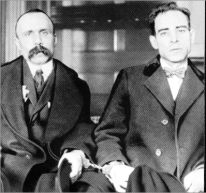 |
Nicola Sacco and Bartolomeo Vanzetti,
three years after their imprisonment. |
The faces of Nicola Sacco and Bartolomeo Vanzetti, seen most often in that famous photograph taken three years after their imprisonment, continue to haunt students of 20th-century American history. Much has been written about the crime of which they were accused, the travesty of justice that was their trial, and how their death-row agony became both a warning to—and a rallying cry for—American immigrant workers.[1]
Though scholarly and popular literature on the Sacco and Vanzetti case is already substantial, National Public Radio recently added yet another interpretation as a segment of The Past Present, a series subtitled "History for Public Radio." Sacco and Vanzetti, which aired first in January, 1999, was produced by Curtis Fox. Two prominent scholars, Nunzio Pernicone and Richard Polenberg, provide most of the historical interpretation; however, the dramatic impact of the program is the result of what is interspersed with the scholarly discussion: snippets from Italian anarchist songs and Woody Guthrie ballads, as well as the comments of Luigi Quintilliano, a comrade of Sacco and Vanzetti, that were recorded in 1967. In addition, actors Joe Grifasi and Spiro Malas read from the prison letters of "the good shoemaker and the poor fishpeddler."[2]
The program is divided into three parts. The first describes and explains the significance of the anarchist political circles in which Sacco and Vanzetti operated. Part II examines the impact of the Palmer Raids, especially upon immigrant, working-class Americans, and the bombing campaign with which some responded to the repression of the First Red Scare. The final segment of the program focuses on the Bridgewater and South Braintree, Massachusetts crimes, the 1920 and 1921 trials, and the ultimate punishment that established the legacy of Sacco and Vanzetti.
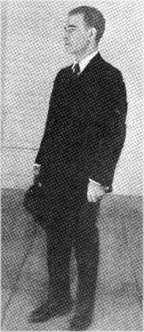 |
Nicola Sacco,
six months following his arrest. |
For the general listening audience, the major point of the introductory portion of the program may come as something of a surprise: Sacco and Vanzetti, though never proven beyond a reasonable doubt to be the murderers of shoe
factory paymaster Frederick Parmenter and payroll guard Alessandro Berardelli, were not simply philosophical anarchists. In a series of alternating commentaries, program narrator Joanne Allen and historian Nunzio Pernicone point out that Sacco and Vanzetti endorsed and perhaps practiced revolutionary violence, at the very least as a means of retaliation against repression. To those familiar with the history of the immigrant left in the United States, this is not a revelation, especially since the appearance of Paul Avrich�s Sacco and Vanzetti: The Anarchist Background in the early 1990's.[3] Nevertheless, Pernicone, who freely acknowledges Avrich�s contribution to current scholarly views of Sacco and Vanzetti, is talking not to an audience of scholars but rather to a presumed audience of intelligent and interested non-specialists. He does a very good job of describing to that audience the world in which Sacco and Vanzetti built their dreams, lived their lives, and eventually died by the authority of the state they so detested.
Nunzio Pernicone, who teaches at Drexel University, is a student of Italian and Italian-American anarchism, and is an authority on that embodiment of early-20th-century immigrant radicalism, Carlo Tresca. In Part I of the program, Pernicone, interviewed by New York radio talk show host Leonard Lopate, discusses the pre-migration backgrounds of Sacco and Vanzetti, and the anarchist movement in both Italy and the United States. Both Sacco and Vanzetti came from moderately prosperous peasant families. Consequently, Pernicone informs us, their primary motivations for emigrating were other than economic. Sacco was driven westward by a sense of adventure and a desire for improvement, while Vanzetti left his homeland in sorrow after his mother�s death. Both men arrived in the United States in 1908.
Nunzio Pernicone on anti-immigrant,
anti-Italian sentiment.
|
|
28.8
| 56k
|
Progressive-Era America responded with hostility to most immigrants; however, Italians were at the "very bottom rung" because of the "Nordicism" that dominated American social thought.
Pernicone testifies that Anglo-Protestant Americans often regarded Southern Italians as non-whites, as evidenced by at least 39 reported lynchings of Italians in the United States. Both Sacco and Vanzetti suffered the insults and indignities of this particularly racist period; but they adjusted rather differently to American life. Sacco, mechanically inclined and with some artisanal education, became an edge trimmer in a Massachusetts shoe factory.
He married, had two children, lived moderately well, and even had $1,500 in the bank on the day he was arrested. Vanzetti had fewer saleable skills, so he worked at a series of punishingly menial jobs,
living close to poverty, and never marrying.
Yet he was an intelligent man with the romantic soul
Spiro Malas reads Vanzetti's
letter to Alfonsina Brini. |
|
28.8
| 56k
|
of a poet and a passion for social justice, a characterization supported by actor Spiro Malas� dramatic reading from one of Vanzetti�s 1921 letters to his former landlady, Alfonsina Brini.
Neither Sacco nor Vanzetti had been an anarchist in Italy: it was the exploitation of working-class life in the United States that convinced both men that the present system must be destroyed. Yet, according to Pernicone, it was not primarily their individual economic hardships that drove Sacco and Vanzetti to anarchism, but rather their concern for others, their shared sense that all the working poor were being oppressed. Moreover, like most of their comrades within the immigrant anarchist community, Sacco and Vanzetti believed that human beings were naturally socialist: it was the institution of private property and its absolute protection by a powerful state that had corrupted human society. Thus the only way to redeem humankind was to abolish private property, at least in its socially-significant forms, and destroy the state. This was not a task for dreamers. The property-protecting state was itself well protected—by police and soldiers and magistrates and executioners. To destroy such an structure would take sacrifice and would require violence. Revolutionary violence, to Sacco and Vanzetti, was a wholly acceptable response to the institutionalized violence which was the foundation of the modern state.
Sacco, who was a relatively prosperous worker, wrote to his daughter Ines,
just weeks before his execution, that he felt his life had been blessed by the affection of his daughter, son, and wife.
Joe Grifasi reads Sacco's
letter to daughter Ines. |
|
28.8
| 56k
|
Nevertheless, his willingness to sacrifice that blessed life had emerged from his sadness over the plight of so many others who lived "the nightmare of the lower classes."
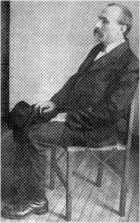 |
Bartolomeo Vanzetti,
before the Dedham trial. |
Pernicone, further explaining the allure of anarchism to Sacco and Vanzetti, spends about 10 minutes discussing the European roots of the movement, the distinctions between anarchists and communists, and the significance of Luigi Galleani, both to immigrant radicalism in the US, and to the eventual fate of Sacco and Vanzetti.
He explains that classic anarchists like Kropotkin were strongest in their critique of existing social relations rather than in advancing plans for a reconstructed society.
In fact, the mere making of a plan, according to purists, would constitute an authoritarian mode. Anarchists, hostile to the communist version of revolution as being authoritarian, touted instead the concept of "mutual aid," a model under which all people would cooperate voluntarily to do what was necessary. Asked by his interviewer how such idealism soon degenerated into terrorism against the innocent, Pernicone responds that, first of all, to the anarchists, few of their targeted victims were "innocent"; second, terrorism was a result of the decline of the movement after 1881, and of the inability of anarchists to precipitate collective revolt.
Luigi Galleani, the vitriolic anarchist agitator and publisher, strongly affected immigrant Italian radicalism, especially in several New England states. According to Pernicone, one reason Italian leftists were particularly targeted during the post-World War I Red Scare was because of the high profile of Galleani, whose Cronaca Sovversiva was identified as the most seditious newspaper in America. Pernicone very skillfully connects Galleani�s fate to the later arrests of Sacco and Vanzetti. His assertion that the April 1919 bombing campaign may have been a response to the deportation of Galleani is quite plausible, given the timing of the two events. The bombings of A. Mitchell Palmer�s residence, the last of which destroyed the front part of the house and killed the probable perpetrator, provided a trail of circumstantial evidence that eventually led authorities to Sacco and Vanzetti.
At this point, Richard Polenberg, Goldwin Smith Professor of American History at Cornell University and widely-published author, joins Pernicone to discuss the crime, trial, and punishment of Sacco and Vanzetti.
Polenberg, whose comments are occasionally augmented by those of narrator Joanne Allen, describes the events of both the Bridgewater attempted robbery and the South Braintree robbery and murders concisely.
|
Richard Polenberg on the arrest and treatment of Italian radicals. |
|
28.8
| 56k
|
What is clear from Polenberg�s observation is that Italian radicals were the assumed perpetrators; arrests were made even before evidence surfaced.
Both Sacco and Vanzetti were immediate suspects in the bungled Bridgewater robbery attempt. A case against Sacco was not pursued only because his alibi was irrefutable: he had clocked into work prior to the robbery attempt, and had not clocked out until considerably afterward. Vanzetti also had what might appear to be a solid alibi: 15 witnesses testified that he sold them Christmas eels at the time of the robbery. Unfortunately for Vanzetti, the jury discounted the testimony of these 15 witnesses because they were Italian. Following his quick conviction, Judge Webster Thayer sentenced Vanzetti to the maximum term of 15 years for armed robbery. Immediately following the South Braintree crime, the local police chief decided, "on the basis of no evidence whatsoever," according to Pernicone, that the criminals must again be Italian anarchists: he proceeded to round up all who fit the description, including Nicola Sacco.
Who Will Remember?
Joan Baez on Judge Thayer. |
|
28.8
| 56k
|
Polenberg explains why most scholars have concluded that the trial of Sacco and Vanzetti was unfair: much of the evidence was tainted, and the prosecution knew it; they obscured witnesses who claimed not
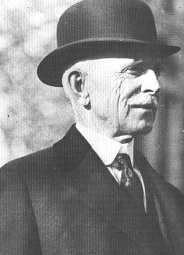 |
Judge Webster Thayer.
|
to have seen Sacco and Vanzetti at the scene of the crime; and, the accused were never selected by witnesses from a lineup, but rather were forced to pose alone as robbers! Michael Mussmano, former attorney for Sacco and Vanzetti and later a conservative Pennsylvania jurist, states that there is convincing proof that the trial judge (Webster Thayer, again) was biased against Italian Americans, and that his bias had infected the jury. Polenberg and Pernicone, however, differ on the effect anti-Italian prejudice had on the trial�s outcome. Polenberg argues that a fair-minded, unprejudiced jury might have found Sacco and Vanzetti guilty based solely on the evidence as it was presented, since they were unaware of its tainted nature. Pernicone, on the other hand, believes that an un-biased evaluation of the evidence, tainted though it was, would have led any fair-minded jury to the conclusion that, at the least, the state had not proven the guilt of the accused beyond a reasonable doubt. Hence, prejudice, to Pernicone, was a major factor in the conviction of the two Italian anarchists.
Luigi Quintilliano on his
belief in the innocence
of Sacco and Vanzetti. |
|
28.8
| 56k
|
Though most scholars agree with the program�s historians that the Sacco and Vanzetti trial was unfair, that the appeals process in place in Massachusetts at the time virtually assured the sustaining of the original verdict, and that the much-respected Lowell Commission had begun writing its conclusion that the trial was fair before it heard all the evidence, there is still no absolute conclusion regarding the actual guilt or innocence of either or both men. Toward the end of the program, the question of guilt is addressed by Luigi Quintilliano,
a comrade of Sacco and Vanzetti,
who recorded his reminiscences in 1967. Quintilliano asked each man if he was guilty, and both responded in the negative with such sincerity and conviction that Quintilliano had no doubts regarding their innocence.
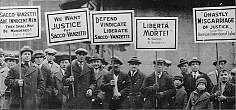 |
One of many protests against
the execution of Sacco and Vanzetti. |
The program ends most dramatically with two personal accounts of the August 23, 1927 executions of Sacco and Vanzetti. Michael Mussmano remembers that he pleaded with prison guards, moments before the execution, to let him in to pursue a last-ditch attempt at a stay. His efforts were refused. "Clearly," says Mussmano, "the state wanted them dead, no matter what."
Luigi Quintilliano�s remembrance is both chilling and somehow strangely consoling. Sacco, he remembers, said goodbye to his family, and then went stoically to his death. Vanzetti, who saw the lights flash in his cell at the moment of Sacco�s execution, was next. Vanzetti
Luigi Quintilliano recalls
the execution. |
|
28.8
| 56k
|
made a brief speech from the electric chair, in which he forgave all those who were about to take his life. Then someone turned a switch, and, "in a few seconds, he was gone."
Curtis Fox and his associates have done an admirable job of both describing the immigrant anarchist world in which Sacco and Vanzetti attempted to live their ideals, and of explaining the significance of their trial, convictions, and executions. Nunzio Pernicone is particularly effective in demonstrating that Sacco and Vanzetti were far from dreamers: they were men willing to take action against what they considered to be an evil system. This depiction is appropriately softened, however, by the dramatic reading of a few of the prison letters.
The program is marred by only a few problems. The music used to introduce the different segments is evocative,
|
Unidentified Italian music. |
|
28.8
| 56k
|
but none of it is identified. The Woody Guthrie selections are easy enough to place; but I would have appreciated some information regarding the Italian selections. Those not familiar with the history of the American Left might have a difficult time following the section of the program on the anarchist background, especially since Pernicone races through terms like Cronaca Sovversiva (Galleani�s paper) at full throttle. Yet these are minor criticisms of what I found to be a moving re-telling of the Sacco and Vanzetti story. No reading of the account of the final moments of the two men can possibly convey the dignity of Sacco and Vanzetti as poignantly as does listening to the words of Luigi Quintilliano, as he remembers his comrades� "agony" and "triumph" with a respect undiminished by the passage of time.
Charles A. Zappia
San Diego Mesa College
NOTES:
- A partial sampling of the literature includes: Paul Avrich, Sacco and Vanzetti: The Anarchist Background (Princeton: Princeton University Press, 1991); Herbert B. Ehrmann, The Case That Will Not Die: Commonwealth vs. Sacco and Vanzetti (Boston: Little Brown, 1969); David Felix, Protest: Sacco-Vanzetti and the Intellectuals (Bloomington: Indiana University Press, 1965); Louis Joughin and Edmund M. Morgan, The Legacy of Sacco and Vanzetti (New York: Quadrangle Books, 1964); Francis Russell, Tragedy in Dedham: The Story of the Sacco-Vanzetti Case (New York: McGraw-Hill, 1962); Francis Russell, Sacco and Vanzetti: The Case Resolved (New York: Harper and Row, 1986); William Young and David E. Kaiser, Postmortem: New Evidence in the Case of Sacco and Vanzetti (Amherst: University of Massachusetts Press, 1985). [Return]
- These words come from a well-known statement attributed to Bartolomeo Vanzetti by a reporter, Philip D. Strong, who visited him in prison three months before his execution. For an account of the controversy over the authenticity of the statement, see Richard Polenberg�s introduction to Marion Denman Frankfurter and Gardner Jackson, eds. The Letters of Sacco and Vanzetti (New York: Penguin Books, 1997), pages xxxi-xxxvii. [Return]
- Paul Avrich, Sacco and Vanzetti: The Anarchist Background (Princeton: Princeton University Press, 1991). [Return]
Photographs: All photographs are in the public domain and widely available in books and Web sites on Sacco and Vanzetti.
~ End ~
Audio Review of Sacco and Vanzetti.
Copyright © 1999 by The Journal for MultiMedia History
With the permission of producer Curtis Fox, The Journal for MultiMedia History presents Sacco and Vanzetti in its entirety. To facilitate listening, we have divided the original 1-hour program into three parts.
Sacco and Vanzetti: Part I
The anarchist political circles
of Sacco and Vanetti. |
|
28.8
| 56k
|
Sacco and Vanzetti: Part II
Immigrants, working-class Americans, and repression. |
|
28.8
| 56k
|
Sacco and Vanzetti: Part III
Massachusetts, 1920-21:
arrest, trial, and execution. |
|
28.8
| 56k
|
|
Comments
| JMMH
Contents
|




